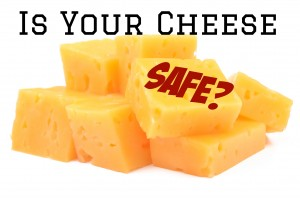
In 2009 and 2010 two strains of the potentially fatal pathogen Listeria monocytogenes infected 34 people in Austria, resulting in eight deaths.
The source of the outbreak was contaminated Quargel, a traditional Austrian curd cheese, produced at a Hartburg dairy.
Recently, experts from the University of Veterinary Medicine in Vienna analyzed the contaminated cheese in an attempt to uncover the source of the contamination. Listeria monocytogenes is an extremely dangerous pathogen having the highest mortality rate of all foodborne illnesses. Through their research they discovered that the distinct strains had not evolved from a common ancestor and had entered the food chain independently.
The first contamination event occurred during the time period of June 2009 through January 2010. The initial pathogen was extremely invasive, containing four virulent genes. It easily and quickly infected the epithelial cells of the liver and intestines and was responsible for 14 cases of infection, five of which resulted in death.
The second strain emerged during the time period of December 2009 and January 2010. This highly infectious strain affected immune-system cells known as macrophages and ultimately resulted in infecting 20 more individuals and causing three deaths.
While the production of the contaminated cheese was immediately halted and the products recalled, a total of eight individuals lost their lives while others were made terribly ill.
“It is absolutely essential that appropriate disinfectants are used properly, lots of salt, and that possible food for the bacteria be limited. Any products listeria is found in must be recalled immediately,” explained Listeria expert and co-author of the study Stephan Schmitz-Esser. And while most factories strive to maintain the highest quality of hygiene, outbreaks of Listeria can occur quickly and spread rapidly.
In 2013, a multistate outbreak was linked to contaminated cheeses produced by the Wisconsin-based Crave Brothers Farmstead Cheese Company and just recently the dangerous pathogen forced a recall of cheese products from Parkers Farm Acquisition, LLC of Minnesota.
Not only are consumers at risk, but manufacturers suffer great losses as recalls are expensive and contamination means shutting down production for as long as necessary until the source can be identified and proper sanitation procedures are put in place.
How to protect yourself from foodborne illness
Dangerous pathogens such as Listeria are most commonly tied to cold ready-to-eat chicken, manufactured ready-to-eat meats (yet another reason to avoid these), soft cheeses, pre-prepared, pre-packed or self-serve fruit or vegetable salads, raw meat and even freshly squeezed fruit and vegetable juices. The most at-risk individuals are infants, the elderly, the immunocompromised and pregnant women – as infection can lead to miscarriage.
To reduce your risk of contamination be sure to thoroughly wash all utensils, cutting boards, countertops and sinks after preparing raw meats and wash all produce before eating (even if it is organic, it can still become contaminated). Higher-risk groups should avoid ready-to-eat meats or heat them before consuming.
And for those looking to avoid packaged cheese altogether, making your own is simple. A basic list of cheese-making supplies include:
- A large pot
- Thermometer
- Measuring cups
- Wooden spoons
- Cheesecloth
- Cheese press
- Milk of choice
- Rennet
- Cultures
If you’ve got the patience for heating and stirring, cheese-making can be a fun and creative process. And for those looking for a vegan-alternative, nut cheeses are a snap to make. Here are two recipes for either the dairy-lover or those who are all about nuts.
Mozzarella Cheese
1. In large pot, heat milk to 90°F, stirring frequently.
2. When milk is at 90°F, add culture, stir well, cover, and allow to ferment for 45 minutes.
3. After 45 minutes, stir well to homogenize the milk, and slowly fold in rennet.
4. Allow the cheese to set for 60 to 90 minutes. You should see a layer of mostly clear whey floating on top of the curd.
5. Using a long knife, cut the curds into 1/2-inch cubes and allow to set for 20 minutes. Do not stir.
6. Slowly heat the curds to 100°F, stirring frequently. Once the curds are at 100°F, turn off the heat and allow to set for 5 minutes.
7. Drain the whey from the curds.
8. Fill your sink with 110° to 120°F water, and set the pot containing the curds into the sink. Allow to set at this temperature for 2 to 3 hours. Every 30 minutes, use your hands to press the whey from the curds and flip the curds over.
9. Cut the curds into four equal pieces; these will be your balls of mozzarella. Set three of the pieces aside.
10. Heat water to between 170° and 190°F. Pour the water over the first piece of mozzarella, working it with your hands until it is smooth, shiny, and stretchy.
11. Form into a ball and place in a bowl of cold water to firm up.
Basic Almond Cheese
1. Soak 1 cup of almonds overnight in water. Drain and pop off skins.
2. Place almonds, a tablespoon of lemon juice, ¾ cup water, 2 tablespoons olive oil and garlic or desired herbs in food processor. Process until smooth.
3. Place nut mixture in nut-milk bag or colander lined with cheesecloth.
4. Give a light squeeze and place in refrigerator overnight to set.
5. You can use the cheese at this point or if you want it more firm, place it in the dehydrator for six or more hours at 115 degrees F to form a rind.
Source

No comments:
Post a Comment